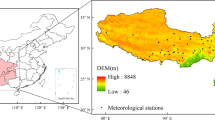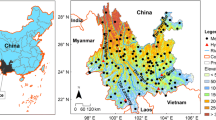Abstract
It has been widely accepted that the global climate will change, with a ‘dry gets drier, wet gets wetter’ pattern. Recent studies found that such changes were overestimated. Drought/wetting variations were detected in a semiarid and sub-humid transitional region of China. The aridity index based on precipitation and reference evapotranspiration was applied to estimate drought/wetting variations. The results showed that the climate in the annual mean of the Zhangjiakou region showed a wetting trend from 1960 to 2017. The wetting trend also occurred in January, February, May and the wet season, especially in June, and in September, October, December and the dry season, and the wetting trend was significant. However, the drought trend occurred in March, April, July, August and November. Moreover, the most obvious wetting and drought changes occurred in September and August, respectively. Climate drought/wetting conditions are primarily driven by precipitation. Although increasing temperatures resulted in enhanced evaporation, precipitation increased, which could offset the increase in evaporation. In addition to precipitation and temperature, humidity was an important influencing factor on drought/wetting variation. The impact of humidity on drought/wetting conditions was greater than that of temperature in January, February, July, August and September. The influencing factors of drought/wetting variations are complicated in the Zhangjiakou region and are mainly influenced by the southeast monsoon, southwest monsoon and plateau monsoon in the Tibetan Plateau, westerly circulation and West Pacific subtropical high.






Similar content being viewed by others
References
Allen RG, Pereira LS, Raes D, Smith M (1998) Crop evapotranspiration-guidelines for computing crop water requirements-FAO irrigation and drainage paper 56, FAO-Food and Agriculture Organisation of the United Nations
Asadi Z, Mohammad A, Sivakumar B, Sharma A (2015) Assessment of global aridity change. J Hydrol 520:300–313
Cayan DR, Das T, Pierce DW, Barnett TP, Tyree M, Gershunov A (2010) Future dryness in the southwest US and the hydrology of the early 21st century drought. P Natl Acad Sci USA 107:21271–21276
Chou C, Chiang JC, Lan CW, Chung CH, Liao YC, Lee CJ (2013) Increase in the range between wet and dry season precipitation. Nat Geosci 6:263–267
Cook ER, Woodhouse CA, Eakin CM, Meko DM, Stahle DW (2004) Long-term aridity changes in the western United States. Science 306:1015–1018
Dai AG (2012) Increasing drought under global warming in observations and models. Nat Clim Chang 3:52–58
Feng H, Zhang M (2015) Global land moisture trends: drier in dry and wetter in wet over land. Sci Rep-UK 5:18018
Greve P, Orlowsky B, Muller B, Sheffield J, Reichstein M, Seneviratne S (2014) Global assessment of trends in wetting and drying over land. Nat Geosci 7:717–721
Homdee T, Pongput K, Kanae S (2016) A comparative performance analysis of three standardized climatic drought indices in the Chi River basin, Thailand. Agriculture and Natural Resources 50:211–219
Kendall MG (1975) Rank correlation methods. Charles Griffin, London
Lesk C, Rowhani P, Ramankutty N (2016) Influence of extreme weather disasters on global crop production. Nature 529:84
Li XZ, Ma ZG, Liu XD (2006) Inter-decadal characteristics of aridification over northern China associated with the variation of atmospheric circulation during the past 50 years. Chin J Atmos Sci 30:277–284
Li Z, Chen YN, Fang GH, Li YP (2017) Multivariate assessment and attribution of droughts in Central Asia. Sci Rep-UK 7:13–16
Liu H, Liu H (2012) A study on the change trends of regional water resource carrying capacity. In: Yang Y, Ma M (eds) Green communications and networks. Lecture notes in electrical engineering, vol 113. Springer, Dordrecht
Ma GZ, Shao LJ (2006) Relationship between dry/wet variation and the Pacific Decade Oscillation (PDO) in northern China during the last 100 years. Chin J Atmos Sci 30:466–474 (in Chinese)
Ma ZG, Dan L, Hu YW (2004) The extreme dry/wet events in northern China during recent 100 years. J Geogr Sci 14:275–281
Mann HB (1945) Non-parametric test against trend. Econometic 13:245–259
Polson D, Hegerl GC (2017) Strengthening contrast between precipitation in tropical wet and dry regions. Geophys Res Lett 44:365–373
Sauchyn DJ, Barrow EM, Hopkinson RF, Leavitt PR (2004) Aridity on the Canadian plains. Géog Phys Quatern 56:247
Sheffield J, Wood EF, Roderick ML (2012) Little change in global drought over the past 60 years. Nature 491:435–438
Sherwood S, Fu Q (2014) A drier future? Science 343:737–739
Spinoni J, Naumann G, Vogt J, Barbosa P (2015) European drought climatologies and trends based on a multi-indicator approach. Glob Planet Chang 127:50–57
Sun B, Gao Z, Li Z, Wang H, Li X, Wang B, Wu J (2015) Dynamic and dry/wet variation of climate in the potential extent of desertification in China during 1981–2010. Environ Earth Sci 73:3717–3729
Thornton PK, Ericksen PJ, Herrero M, Challinor AJ (2014) Climate variability and vulnerability to climate change: a review. Glob Chang Biol 20:3313–3328
United Nations Environment Programme (UNEP) (1992) World Atlas of Desertification
Usman MT, AbdulKadir A (2013) On determining the ‘real’ onset date of seasonal rains in the semi-arid and sub-humid areas of West Africa. Nat Hazards 66:749–758
Vicente-Serrano SM (2007) Evaluating the impact of drought using remote sensing in a Mediterranean, semi-arid region. Nat Hazards 40:173–208
Wang L, Xie X, Li Y (2004) Changes of humid index and borderline of wet and dry climate zone in northern China over the past 40 years. Geogr Res-AUST 23:45–54
Wang X, Cui Q, Li S (2012) An optimal water allocation model based on water resources security assessment and its application in Zhangjiakou region, northern China. Resour Conserv Recycl 69:57–65
Wang S, Huang J, He Y, Guan Y (2014) Combined effects of the Pacific decadal oscillation and El Nino-southern oscillation on global land dry–wet changes. Sci Rep-UK 4:6651
Wu S, Yan X (2019) Variations in droughts and wet spells and their influences in China: 1924–2013. Theor Appl Climatol 135:623
Yang JP, Ding YJ, Chen RS, Liu LY (2003) The fluctuation of day and wet climate boundary and its causal analyses in China. Acta Meteorol Sin 61:364–373
Zarch MAA, Sivakumar B, Sharma A (2015) Droughts in a warming climate: a global assessment of standardized precipitation index (SPI) and reconnaissance drought index (RDI). J Hydrol 526:183–195
Zhang KY, Li CG (2010) Analysis of water resources current situation in Zhangjiakou. Hahai Water Resour 6:10–11 (in Chinese)
Zhou L, Wu J, Mo X, Zhou H, Diao C, Wang Q, Chen Y, Zhang F (2017) Quantitative and detailed spatiotemporal patterns of drought in China during 2001–2013. Sci Total Environ 589:136–145
Acknowledgements
We thank the editor and two anonymous reviewers for their constructive comments, and the Meteorology Information Centre of the Chinese National Bureau of Meteorology for permission to access the meteorological data.
Funding
This work was supported financially by the National Major Science and Technology Program for Water Pollution Control and Treatment of China (2017ZX07101001) and the Strategic Priority Research Program of the Chinese Academy of Science (XDA19040102).
Author information
Authors and Affiliations
Corresponding author
Ethics declarations
Conflict of interest
The authors declare that they have no conflict of interest.
Additional information
Publisher’s note
Springer Nature remains neutral with regard to jurisdictional claims in published maps and institutional affiliations.
Rights and permissions
About this article
Cite this article
Zhou, Y., Lu, C. Drought/wetting variations in a semiarid and sub-humid region of China. Theor Appl Climatol 140, 1537–1548 (2020). https://doi.org/10.1007/s00704-020-03171-x
Received:
Accepted:
Published:
Issue Date:
DOI: https://doi.org/10.1007/s00704-020-03171-x




